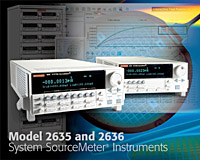Keithley Instruments, Inc., a leader in solutions for emerging measurement needs, announces two new additions to its Series 2600 SourceMeter(R) Instruments to create the industry's most advanced and cost effective solution for semiconductor parametric analysis and testing. The Models 2635 and 2636 represent a new and unique way of doing parametric analysis at resolutions as fine as 1fa (10(-15) amp), which is often required for many semiconductor, optoelectronic, and nanotechnology devices. Moreover, their instrument-based, multi-channel architecture results in a 50 percent lower cost than typical mainframe-based source-measure solutions. With their Test Script Processor (TSP(TM)) and TSP-Link(TM) intercommunications bus, these new instruments enable engineers to quickly create fast test systems that are ideal for research, characterization, wafer sort, reliability, production monitoring, and a multitude of other test applications.
 Series 2600 SourceMeter Instruments
Series 2600 SourceMeter Instruments
The Models 2635 and 2636 provide cost-effective DC and pulse testing from femtoamps and microvolts up to 200V/1.5A. They operate with or without a PC, providing test speeds up to four times faster than typical mainframe-based source-measure solutions. Moreover, each includes a PC-like microprocessor to enable easy programming and independent execution of test programs (scripts) ranging from the simple to complex, including sourcing, measuring, test sequence flow control, and decisions with conditional program branching. Since they can be easily integrated with other instruments in automated systems, they will be very attractive to component manufacturers and semiconductor fabricators for wafer level testing and packaged device testing. At the same time, their low cost makes them attractive to researchers and academics in a wide variety of disciplines that require fast and easy I-V characterization of devices and materials.
Easy Scalability for Lowest Cost of Ownership
The Models 2635 and 2636 enable users to significantly reduce their cost of test for low and medium pin count devices or multiple devices and material samples. They operate as five precision instruments in a single box: SMU (source-measure unit), DMM (digital multimeter), bias source, low frequency pulse generator, and arbitrary waveform generator. These functions are controlled by TSP, which enables fully programmable sequences to be downloaded and executed within the instrument. This eliminates communications and PC overhead for critical throughput gains, while allowing complete flexibility in controlling and adapting to different test situations.
In addition to TSP, Keithley's TSP-Link master/slave connection provides a high-speed, low-latency interface to other TSP-based instruments, enabling simple multi-box and multi-instrument software control. A major benefit is easy scalability of Series 2600 test systems according to present and future needs. Multiple single-channel (Model 2635) units and dual-channel (Model 2636) units can be integrated seamlessly without a host mainframe. This mainframeless scalability allows system sizes up to 32 channels per GPIB address, while minimizing cost, rack space, and time required when adding future channels. By using selected products in the Series 2600, users can standardize on two or three SMU models to cover tests up to 10A pulse or 3A DC in a wide range of applications. The SMUs can then be re-purposed by simply changing the test scripts they execute.
Shorter Test Times
All of Keithley's TSP-based systems are capable of storing and running thousands of lines of code for predefined device tests that include limit comparisons, pass/fail decisions, parts binning, etc., and they all work with or without a PC controller during test execution. Furthermore, their digital I/O can directly control probers, handlers, and other instruments, while TSP-Link allows users to execute high-speed automated tests across multiple channels and instruments without GPIB traffic. This results in test time reductions as large as 10X compared to older sequencing instruments; 2X to 4X test time reductions are common in component testing.
When the Models 2635 and 2636 are combined with Keithley's new Series 3700 System Switch/Multimeter instruments, which also incorporate TSP and TSP-Link, an even broader range of high-speed applications can be served. Together, these two product series provide the fundamental building blocks that enable tightly integrated high-performance switching and multi-channel I-V measurements. Test engineers can use them to easily create low-cost ATE systems optimized for high throughput in applications such as semiconductor stress testing and functional packaged device tests.
Easy System Development
Historically, it has been a challenge to develop multi-instrument characterization or ATE systems for basic R&D and high-speed production testing. Keithley solves this problem with two free software tools that greatly simplify systemization of the Series 2600 SourceMeter Instruments. For R&D and curve tracing applications, Keithley's LabTracer(TM) 2.0 software controls up to eight SourceMeter Instrument channels to perform device characterization with no programming whatsoever. This software allows the user to fully configure each channel, run device parameter tests, and plot test data - simply and easily.